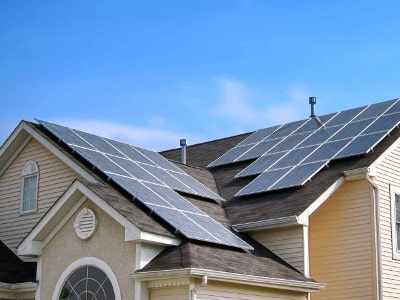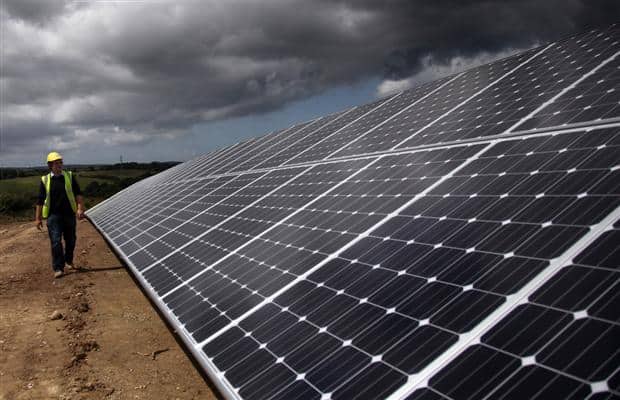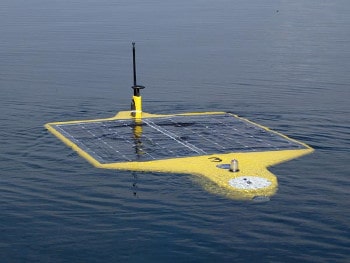
 Canadian solar stocks come in and out of fashion. For the better part of four decades, solar energy has come in and out of fashion, like skinny ties or flambé Crêpes Suzette. But lost in the boom and bust nature of funding for the nascent technology may be the fact that the industry has made consistent incremental improvements.
Canadian solar stocks come in and out of fashion. For the better part of four decades, solar energy has come in and out of fashion, like skinny ties or flambé Crêpes Suzette. But lost in the boom and bust nature of funding for the nascent technology may be the fact that the industry has made consistent incremental improvements.
In 2009, First Solar (NASD:FSLR) brought the cost of manufacturing its solar panels down to a dollar per watt, a milestone that has been improved by 25% in the short time since.
Solar panels have become less obtrusive and efficient with the use of improved processes, and with the use of advanced materials such as silica crystal. Research firm Global Industry Analysts says the market for solar panels could be $71.8 billion by 2017, driven by the US and the Chinese market, which is expected to increase 230% this year alone, exceeding 1.6 gigawatts. Even the Greeks are getting in on the game. that country recently unveiled a $28 billion plan for building a 10 gigawatt solar power plant.
Canadian solar stocks come in and out of fashion. But lost in the boom and bust is the fact that the industry has made consistent incremental improvements.
Canada’s solar plays, on the whole, have had a bumpy ride of late. But with international scope and experience are they poised to benefit from an upswing in adoption that may be the most dramatic yet? Cantech Letter gives you Canada’s 10 Most Interesting Solar Stocks, listed in order based on the most recently reported annual revenues.
1. Northland Power (TSX:NPI)
2010 Revenue: $312.4 million
Until the first day of this year, Toronto’s Northland Power wasn’t a stock at all, but an income fund. When it converted to a Canadian public corporation on January 1st of this year it became part of the TSX Cleantech Index, and one of Toronto’s largest tech stocks. Northland’s solar, wind biomass and run-of-river projects concern, generate near a thousand megawatts of generating capacity, or enough to power all but the largest of cities in Canada. Northland currently has thirteen solar projects in Ontario in advanced development. One of those projects is The McLean’s Mountain project, which is located on Manitoulin Island in Lake Huron. When McLean’s is completed in 2012, the company expects it will generate 60MW of power.

2. 5N Plus (TSX:VNP)
2011 Revenue: $178.8 million
A few years ago Montreal’s 5N Plus, which produces essential components of thin-film solar modules, became a primary material supplier to First Solar. When First Solar’s revenue was ballooning, they were being supplied cadmium telluride cells by 5N Plus. The Montreal company, meanwhile, was mirroring the action, albeit on a much smaller scale. Sales increased from $10.3 million for the fiscal year ended May 31, 2005 to over $70 million in fiscal 2010, and more than double that in 2011. The Canadian solar stock price moved from a 2008 low of $3.50 to a high of $9.85 this past March. The relationship still appears rock solid; 5N Plus recently announced new five-year agreement with First Solar that extends the relationship until Dec. 31, 2015. Criticism that 5N was too dependent upon First Solar was quashed with the April acquisition of Belgium’s MCP Group, one of the world’s leading producers of specialty metals such as bismuth, gallium, indium, selenium and tellurium. The acquisition, which cost 5N Plus just over $315 million, dramatically increases its scale. MCP is actually several times larger than 5N Plus; the company generated approximately $462-million of revenue in 2010, and has more than four hundred employees across Europe, Asia and the US.
3. Day4 Energy (TSX:DFE)
2010 Revenue: $166.6 million
Shares of Burnaby’s Day4 Energy were slammed during the economic crisis of 2008 and have never recovered. The company, which designs and sells solar photovoltaic products, has been a perpetual money-loser, but the increase in the company’s top line has been just as dramatic as its fall from grace with investors. Day4 Energy’s revenue increased from under $21 million in 2007 to $166.6 in fiscal 2010. Day4, like many other of the companies listed here has a large presence in Germany, but has worked to diversify regionally. In 2010 sales to the Italian market were $76.6 million compared with just $4.3-million in 2009. The company also made sales to emerging markets such as Australia.
4. Timminco (TSX:TIM)
2010 Revenue: $133 million
Has Canada seen a more compact and dramatic rags-to riches-to rags story than that of Timminco? The spectacular rise and fall of the Toronto based solar-silcon and silcion metal producer seems to be torn from the pages of a Hollywood script or Broadway musical. In late 2006, Timminco shares were worth pennies, closing that year at $.30. The stock hit nearly $34 three summers ago. In between was a time when the company claimed it had developed a new process to purify silcon for use in solar panels. If they were right, investors surmised, the ramifications were absolutely massive.On the other side were those who felt the technology Timminco claimed to have invented was too good to be true, a belief that was no doubt furthered by the fact that Timminco was extremely secretive about the process and even its customers. Each side had its champions; in April of 2008, Ravi Sood of Lawrence Asset Management (now Navina Asset Management Inc) appeared on BNN, saying that “There is no evidence that they have any sort of proprietary technology. There is no evidence that they can actually deliver on their claims”. Notorious Wall Street short stock seller, Manuel Asensio, joined in and began openly shorting Timminco. Jean-Francois Tardif and Peter Hodson, whose firm Sprott Asset management held a large position in Timminco, issued buy recommendations on the stock. Ultimately, those who shorted Timminco in 2008 were big winners, as the stock fell to pennies and never recovered. Today the company is still losing money, but increased its revenue from $104.5 million in 2009 to $133 million in 2010.

5. Arise Technologies (TSX:APV)
2010 Revenue: $73.85 million
It has not been a pretty three and a half years for shareholders of Arise. Coinciding with the opening of its first photovoltaic cells plant in Bischofswerda, Germany, shares of the company raced to to $2.53 on April 11th of 2008. But, perhaps without even knowing it, Arise began playing a dangerous game of musical chairs that year. When the music stopped, in the form of a global recession and an increasingly out of favor sector, the company was still hemorrhaging cash. The losses meant Arise had to go back to market to raise money, a prospect that was increasingly dilutive. By the time 2010 ended the company had more than 250 million shares outstanding, and a share price of just $.165 cents. The company’s troubles (Arise is currently facing a TSX delisting review and, earlier this month, placed its German unit into insolvency) have overshadowed their successes to a large degree. The Waterloo based solar player has had tremendous growth in its topline, from barely a million in revenue in 2007 to more than $73 million in fiscal 2010, but the company is still very much in the red; Arise lost $4.6 million in its recently reported Q2.
6. Carmanah Technologies (TSX:CMH)
2010 Revenue: $33.92 million
Victoria’s Carmanah went public in 2001 and graduated to the TSX in 2005. By 2006 the company, which had matured into one that provided solar lights for a variety of industrial off the grid applications, including hazard lights and lights for airport runways, had grown to near $63 million in revenue. As 2008 turned to 2009, however, it was becoming clear that many of the product lines the company was engaged in, such as its roadway signage and distribution business, were not profitable and probably weren’t going to be. In June of 2008, Carmanah began to slash staff; 37 people or 40% of the company’s staff were cut. While noting the move was particularly hard for employees, CEO Ted Lattimore told the Victoria Times Colonist that the company would not have to suffer through “baggage and suffocation of businesses that are losing money.” Though 2009 produced only half the revenue of the previous year , it also produced something else unfamiliar to its investors; a profit. New CEO Bruce Cousins, who served as an exec at Xantrex Technology and at Ballard Power, hopes to return the company to its glory days.

7. Etrion (TSX:ETX)
2010 Revenue: $11.56 million
For executives of solar energy companies, talking about the future is just part of the gig. Peruse the corporate materials of many solar pubcos and you’ll inevitably find them filled with projections of increased adoption in the face dwindling natural resources and heightened public awareness. Etrion, a company based in Switzerland and listed on the TSX, strikes a more practical tone. Etrion says it invests in “countries with attractive solar irradiation and government incentives for solar power production” and “feed-in-tariff” environments. Translation: Etrion likes to do business where business in sunny and subsidized. Etrion kicked things off in Italy , where it now owns 60 megawatts of solar power plants, with much more in the works. Etrion, which was formerly know as Petrofalcon, went public in 2009 after acquiring the interests of Solar Resources Holding Sarl, or SRH, an Italian company that owned construction permits for solar plants in Italy. The company’s revenue really began to kick in this past year; the company generated $17.8 million of solar electricity revenue in its recently reported Q2 alone.
8. Sustainable Energy (TSXV:STG)
2010 Revenue: $2.12 million
Calgary’s Sustainable Energy has developed a patented process that converts a low voltage current into grid quality power. As the Globe and Mail’s Ian Merringer recently pointed out this is important because the solar industry is, increasingly, moving towards parallel wiring as an improvement from series wiring. Series wiring is akin to the lights of a Christmas tree. Sustainable Energy’s technology removes the “weakest link” effect between panels that comes from snow, dust or shading effects. The company says that by reducing these effects it can increase the efficiency of a solar panel by five to fifteen per cent. Sustainable management cheered the recent reelection of Liberal Dalton McGuinty in Ontario, it believes the Green Energy Program there is set to make it the biggest solar market in North America.
9. Opel Technologies (TSXV:OPL)
2010 Revenue: $1.65 million
The trajectory of Opel International’s (TSXV:OPL) story is not unfamiliar to investors in the space. The company, which was based in New Brunswick but recently moved its offices back to Ontario, went public on the TSXV in June 2007, raising $10.7 million in a reverse takeover. Shares of Opel soared on the promise of its innovation in high-concentration photovoltaic cells, an area in which the company has applied for more than forty patents and been granted twenty one. The company’s stock hit a high of $2.25 in November of that year. But when the recession hit, Opel was hit especially hard, falling to $.12 cents by Halloween 2008. Investors were no doubt taking as much stock of the company’s’ losses, which ended up at just under $6 million for fiscal 2007, as they were the company’s perceived leadership position. Since that time Opel has continued to unveil a string of prestigious grants, awards and pilot projects with institutions such as the National Research Council of Canada and US Department of Defence. Opel is still small, but is starting to generate revenue from projects such as the recently completed turnkey installation for solar power plant for Toray Plastics, will be generate 446-kilowatt the largest solar field in the state of Rhode Island.

Source: NOAA.gov
10. Natcore Technology (TSXV:NXT)
2010 Revenue: Zero
Natcore’s technology, which is licensed from Rice University in Houston, replaces the traditional chemical vapour deposition method used in solar applications with a wet chemistry process. This removes the need for silane, which is highly toxic and flammable. Natcore can also use the waste materials from the initial production of the silicon wafers or from the production of semiconductors, thereby allowing facilities currently using the chemical vapour deposition method to potentially lower their cost of goods. The company believes this technology will replace expensive vacuum based furnaces with a silicon dioxide-based film that is grown in an environmentally friendly chemical bath. Natcore management believes it may singlehandedly allow the solar cell industry to reduce silicon wafer thicknesses by up to two-thirds, an advancement that will dramatically improve throughput and profit margins. This, in turn, could lead to the mass manufacturing of tandem solar cells with twice the efficiency of the best solar cells available today. Until very recently, these tandem cells have been producible only under lab conditions, and at very high costs.
File Under: Canadian Solar Stocks, Canadian Solar Stocks to Watch
Comment
Leave a Reply
You must be logged in to post a comment.




 Share
Share Tweet
Tweet Share
Share




Quite a few of these companies have gone under and have been delisted.
Hello my name is Samantha Davis and I am from Brentwood college on Vancouver Island. For a project, I am doing with my school I am doing research on salt spring island and the if they were to use solar energy. I have a few questions for you to please answer. How much is a fixed Solar Panel for a city of 6000 people going to approximately cost? How much is a rotating Solar Panel going to cost?
Thank you for your time